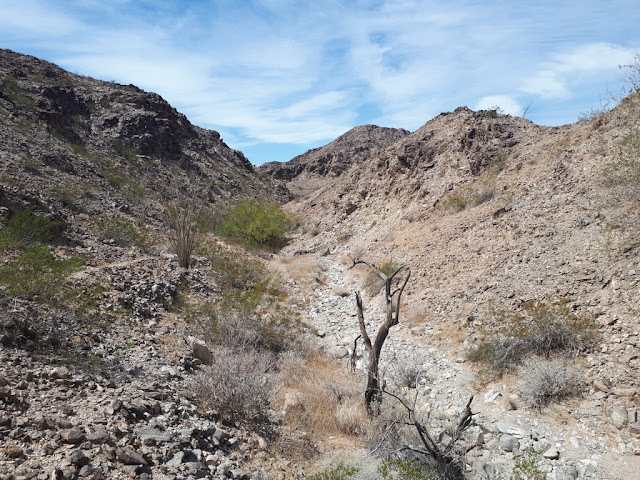One more hike in the nice and warm southwest was waiting for us, right outside of Yuma: Telegraph Mountain, so called for obvious reasons. We chose it for its accessibility; the parking lot is right beside the I-8, the highway we were going to take out of the Yuma area on our way to Mesa.
 |
| Now the Ocotillo blossoms are waiting for insects and hummingbirds |
An information kiosk at the start of the climb informed about the flora and fauna that could be encountered along the way. Seeing a chuckwalla would make my day. Would we be so lucky?
It was a strenuous climb for me, very steep grade in parts, that led us in switchbacks up the mountain. A boulder-filled draw remained to our right all the way up, and to my delight I found another species mentioned in the kiosk at the start: the elephant tree (Bursera microphylla), a type of tree especially adapted to the very arid hills and mountains of the northwest Sonoran desert. It derives its common name from the smooth trunk that resembles a bit the legs of an elephant; in it, and in the lower limbs and wood, it can store water. It is a semi-succulent. I sought the shade of a bigger one partway up – by now it was getting pretty hot – and relished the spicy scent. The peoples of this area have traditionally used the sap for medicinal purposes, and its wood is used by them as well. It is very sensitive to cold and won’t tolerate frost.
After several breaks to catch my breath we finally arrived at the end of the trail, just below the big communication towers. Signs warn not to continue because of the radiation, although an experienced hiker we met up there told us that the views were even more amazing from all the way up; we should, however, not take our cell phones since they might be messed up. I wasn’t going to take any chances with my pacemaker, however, and Johann decided he could see enough from where we were as well. The same hiker pointed out other worthwhile mountains to hike in the vicinity; that is something to keep in mind should we come back here.
Going down, although likely harder on the knees, was a lot easier, and we slowly made our way downhill, enjoying the changing view. We also kept an eye on the draw beside us: we were still hoping to spot a chuckwalla. A movement between the boulders caught our eye: a scaled head poked out of a hole, but that’s as far as it showed itself before withdrawing again. Another lizard was less cautious, and soon we saw four or five coming out to feed on the small leafy plants beside the road. I listened to one particularly enjoying its lunch, climbing right into the dense foliage. Common chuckwallas (sauromalus ater), the kind that lives here, can grow to about 40cm. The males are a bit bigger than the females. They are herbivores and are said to especially like yellow-blossomed plants like creosote or brittlebush, for hydration as well as nutrition, though the ones we observed here obviously had a broader taste. They are very well adapted to the arid conditions here. When they feel threatened they withdraw into rock cavities, wedge themselves in and take deep breaths to further entrench themselves. They can live up to 25 years. I could have stayed and watch them for much longer, but we had some distance to go yet before we landed in Florence, southeast of Mesa, where we had booked a hotel for the night, and we continued down the mountain. This time we took the small trail leading down another draw right down to the parking area. We should have done that on the way up already since the surroundings were much nicer than on the dusty, wide road.
On our way to Florence we passed a few huge feedlots, unlike here in Alberta all stocked with dairy animals. More enjoyable to look at were the hillsides, covered in yellow and purple blossoms. About twenty miles west of the town of Gila Bend we saw the turnoff to the Painted Rock petroglyph site where we camped in the desert last spring. The sky threatened rain, but we arrived in Florence, a (at this time?) quiet town known for its many historic buildings, without getting wet.











No comments:
Post a Comment